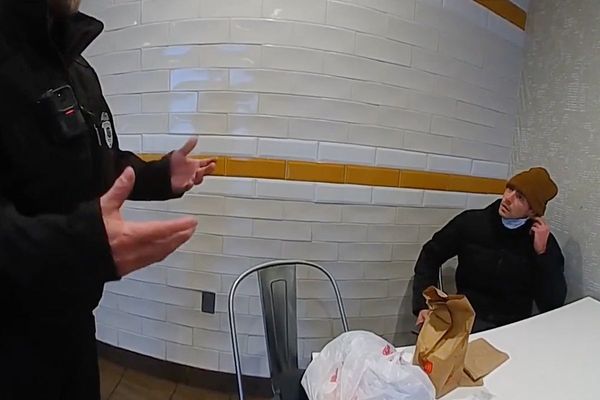
Early exposure to pain can cause long-term changes to children’s nervous systems and make them more sensitive to it in the future. That’s why University of Toronto professor and senior scientist at The Hospital for Sick Children (SickKids) Jennifer Stinson is developing solutions to help take their minds off the doctors, machines and needles.
Medi (medicine and engineering designing intelligence), a half-metre tall robot that greets patients and helps them feel at ease, is one digital intervention introduced to young oncology patients by Stinson, who also serves as co-director of the SickKids Centre for Pain Management, Research and Education. “I’ve always been interested in technology because young people are digital natives,” she says. “The teens I worked with in the chronic pain clinic were all using smartphones, so I thought I could harness the potential of this technology to help them better cope with pain.”
The robot distracts children by telling stories, teaching them how to breathe deeply, singing, dancing and playing games. In her team’s study, patients who interacted with Medi reported a significant reduction in pain, compared with those who didn’t. The team is now planning to enhance the robot’s capabilities with AI. “He can hear and see everything that’s going on in the room and he’s able to pivot [his approach] if a child becomes upset,” Stinson says.
Stinson has dedicated her life’s work to understanding paediatric pain and developing digital interventions to improve care for children and young people. She’s aligned her research with the four transformative goals for paediatric pain, defined by medical journal the Lancet: to make pain matter, understood, visible and better. Stinson’s work has contributed to Canada becoming a world leader in paediatric pain research, and home to the world’s first paediatric pain management standard. In 2025, she became the first nurse to receive the prestigious Peter Gilgan Canada Gairdner Momentum award.
Stinson grew up thinking she wanted to be a doctor but became a paediatric nurse after seeing the “amazing care [nurses] provide in their advocacy” for their patients. Yet, when she started working in clinical settings, she saw that pain management was severely neglected. “Kids weren’t having their pain assessed, and pain medication and other distractions weren’t being used for painful procedures,” she says. “I was frustrated and decided to do my master’s at the University of Toronto to get more research training. That really started my passion for pain.”
Combining clinical and research work has provided her the opportunity to drive innovation, an approach she’s keen to champion for the next generation of nurses too. Today, she’s a professor at the Lawrence Bloomberg Faculty of Nursing at the University of Toronto, ranked the top nursing school in Canada and number four in the world. The faculty spearheads some of the latest innovations in nursing practice, with hands-on teaching facilities in the simulation lab and a doctor of nursing programme, which was a country first for Canada.
This approach helps drive innovation in clinical care more quickly, she says. “Most research takes 17 years or more to get into the hands of patients. I can see what issues are the most pressing for the families and patients I work for, and design better interventions or assessment tools quickly. It really helps decrease that knowledge-to-practice gap.
“When I first started out, there were no nurses in a similar position to me, so I had to rely heavily on my medical colleagues at the university to help carve out my role,” she adds. “Mentorship was a core part of my training and is a big part of my philosophy now, in terms of providing great training to the next wave of nursing leaders and health clinician scientists.”
At SickKids, and as the principal investigator at the iOuch Pain Lab, Stinson’s solutions have targeted conditions such as juvenile arthritis, sickle cell disease, chronic pain and cancer. iCanCope with Pain, for example, is a smartphone app that helps young people manage persistent pain. It contains goal-setting features and forums that provide social support. After six months using the app, young people with sickle cell disease reported 37% fewer days with pain. Other projects include the Pain Squad, an app that uses gamification to help kids track their cancer pain, and iPeer2Peer, a virtual mentoring programme that matches teens with young adults with the same condition. “Most children with a chronic pain condition don’t know anyone else [dealing with chronic pain]. They might not want to talk about it for fear of being stigmatised or left out,” Stinson says. “But we have so much evidence showing that this sort of support helps improve self-management and transition to adult care.” She’s currently working on an app to help children manage post-operative pain.
So far, Stinson has co-designed every project with her patients and is a fierce advocate for their involvement. “They’re key partners in asking: ‘Are these the most important questions we should be researching?’ ‘What are the best methods to do that?’ ‘And once we’ve completed the project, how do we translate that knowledge back into practice?’” At SickKids, Stinson has created a 60-strong patient and family advisory committee to help guide the focus for future research.
When asked about her proudest achievements, Stinson points to her role in training the future workforce of nurses and paediatric pain researchers both at the Lawrence Bloomberg Faculty of Nursing at the University of Toronto and through the Pain in Child Health training programme at SickKids, which has trained more than 400 international clinicians and trainees. She’s also the founding lead of Paediatric Project Echo, a government-funded initiative to train community healthcare providers in the management of complex health conditions, such as chronic pain.
“No one discipline owns pain. Pain should be the responsibility of every single healthcare professional,” says Stinson. “But it really makes my day when someone says they want to go into nursing as a career. That’s why I was proud to receive the Canada Gairdner award because it recognised the important role nurses play in healthcare. Pain has huge implications for children across all aspects of their lives, and there are things we can do to make it better.”
Meet the extraordinary community at the University of Toronto that’s pushing the boundaries of what’s possible







